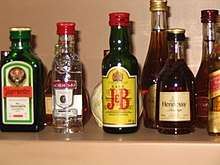Cheongju (beverage)
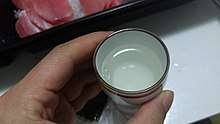 | |
| Type | Rice wine |
|---|---|
| Country of origin | Korea |
| Variants | Beopju, sogok-ju |
| Korean name | |
| Hangul | 청주 |
|---|---|
| Hanja | 淸酒 |
| Revised Romanization | cheongju |
| McCune–Reischauer | ch'ŏngju |
| IPA | [tɕʰʌŋ.dʑu] |
Cheongju (청주; 淸酒; literally "clear wine") is a clear, refined rice wine.[1]
Names
The word cheongju (청주; 淸酒) consists of two syllables: cheong (청; 淸) meaning "clear" and ju (주; 酒) meaning "alcoholic drink". It contrasts with takju (탁주; 濁酒), as "tak" (탁; 濁) means "turbid". The word takju usually refers to makgeolli (milky, unrefined rice wine). The hanja characters 淸酒 are etymologically the same as the kanji pronounced seishu used on the labels of sake.
The native Korean word for "clear wine", malgeun-sul (맑은술), is also used to refer to cheongju.[2] Another name for cheongju is yakju (약주; 藥酒), which often translates into "medicinal wine".[3]
History
According to Things on Korea—a 12th-century book on Korea written by a Song Chinese scholar—the Goryeo people used non-glutinous rice to brew rice wine.[4] Another 12th-century Chinese book, Illustrated Account of Goryeo, reports that Korean rice wine that is made with nuruk is deeper in color and has a higher alcohol content; it says that when drinking this wine one gets drunk quickly and sobers up quickly.[5] This book says that clear, refined rice wine was made in the royal court, while milky, unrefined rice wine was more popular among commoners.
Preparation
Cheongju is usually brewed in winter, between the months of November and March.[6] Steamed rice mixed with nuruk (fermentation starter) and water is left to ferment for 16 to 25 days, at a temperature not higher than 14–16 °C (57–61 °F).[6] During the fermentation process, the rice starch becomes saccharified; the yeast fungi feed on the sugars created by saccharification and produce alcohol. The fermented wine is then filtered with yongsu (a wine strainer), which is dipped into the liquid.[7] The clear wine inside the yongsu is ladled out to make cheongju.[8]
Consumption
Cheongju has been widely used in a variety of traditional rituals and rites, as it is regarded as a well-prepared alcohol.
Varieties
Southern cities in South Korea such as Masan, Gunsan, and Nonsan are famous for producing good cheongju.[6] Beopju brewed in Gyeongju and sogok-ju brewed in Hansan are well-known varieties of cheongju.[9] There also are cheongju varieties made with glutinous rice or black rice.[10][11]
Flavoured cheongju varieites include gukhwa-ju made with chrysanthemum, dugyeon-ju made with rhododendron, songsun-ju made with pine sprouts, yeonyeop-ju made with lotus leaves, and insam-ju made with ginseng.
Similar beverages
Cheongju is similar to Chinese mijiu and Japanese sake. A dry white vermouth can also serve as a substitute for cheongju in cooking.[12]
Gallery
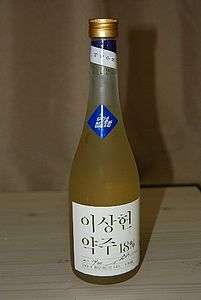 Yi Sangheon yakju
Yi Sangheon yakju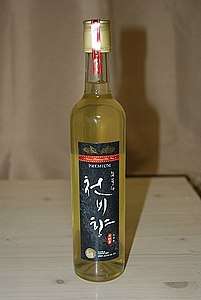 Cheonbihyang
Cheonbihyang Upoui achim
Upoui achim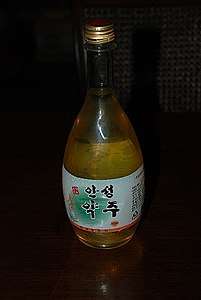 Anseong yakju
Anseong yakju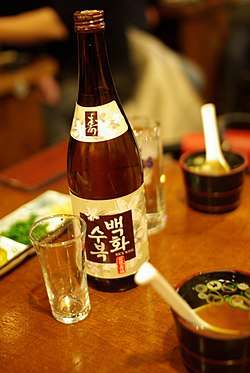 Baekhwa Soobok
Baekhwa Soobok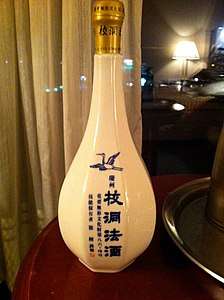
See also
- Gwaha-ju, fortified rice wine
- Mijiu, a Chinese equivalent of cheongju
- Sake, a Japanese equivalent
- Korean alcoholic beverages
References
- ↑ "cheongju" 청주 [refined rice wine]. Korean–English Learners' Dictionary. National Institute of Korean Language. Retrieved 18 May 2017.
- ↑ "malgeun-sul" 맑은술. Standard Korean Language Dictionary (in Korean). National Institute of Korean Language. Retrieved 18 May 2017.
- ↑ "yakju" 약주. Standard Korean Language Dictionary (in Korean). National Institute of Korean Language. Retrieved 18 May 2017.
- ↑ Sūn, Mù (in Literary Chinese). Jīlín lèishì 雞林類事 [Things on Korea]. Song China: Wikisource.
- ↑ Xú, Jīng (1124) (in Literary Chinese). Xuānhé fèngshǐ gāolì tújīng 宣和奉使高麗圖經 [Illustrated Account of Goryeo]. Song China: Wikisource.
- 1 2 3 "cheongju" 청주. Doopedia (in Korean). Doosan Corporation. Retrieved 18 May 2017.
- ↑ Yoon, Suk-Ja; Park, Duck-Hoon (1994). "Study on traditional folk wine of Korea – In the Southern region of Korea – Chulla-do, Kyungsang-do and Cheju-do". Journal of The Korean Society of Dietary Culture. 9 (4): 355–367.
- ↑ Korean Society of Food Science and Technology (2004). Sikpum gwahak gisul dae sajeon 식품과학기술대사전 (in Korean). Seoul: Kwangil Publishing. ISBN 9788986752106 – via Naver.
- ↑ "Traditional Liquors & Wines". Korea Tourism Organization. 12 August 2016. Retrieved 24 May 2017.
- ↑
- ↑
- ↑ Hepinstall, Hi Soo Shin (2001). Growing up in a Korean Kitchen: A Cookbook. Berkeley, CA: Ten Speed Press. ISBN 978-1-58008-281-5.

